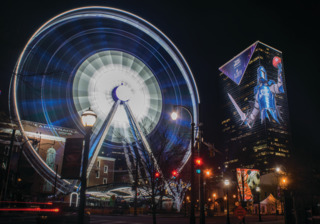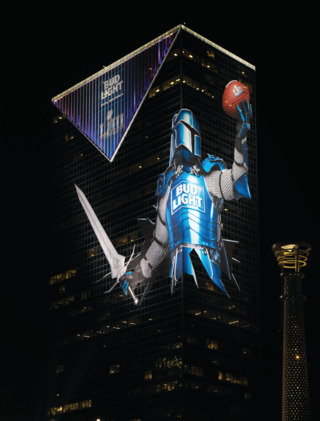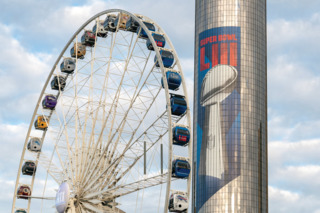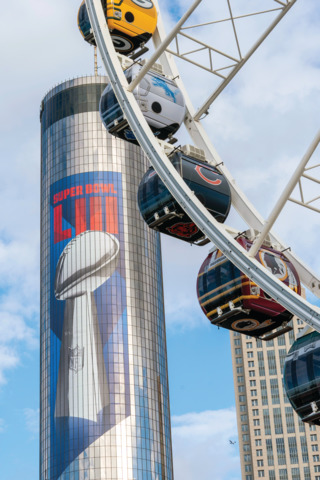The Urban Building Wrap Game
And why playing it can be music to advertisers’ ears.
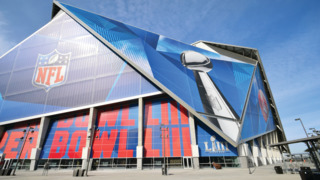
When it comes to winning football games, preparation and execution are two key factors. There are a lot of moving parts -- namely large human bodies -- realigning and making adjustments on the fly to evade or move other large bodies out of their way to the end goal.
Promoting professional football games doesn’t get any bigger than the National Football League’s (NFL) championship game in early February – the “super” international event that cannot be named for fear of trademark infringement. We have, however, received permission to share with WFS readers some slick images of the building wraps that were employed three months ago in Atlanta for the big game tagged with Roman numeral LIII.
Sharing photos and messages is one of the major benefits that lures advertisers to massive-scale building wraps. That’s because wrapping a building is an event in itself. “Observers are curious during the installation process,” says Hayes Holzhauer, executive VP of operations at bluemedia, a national signage company. His firm is based in Tempe, Arizona, but Holzhauer spent a lot of time this past January in Atlanta, where the big game was played.
“People want to take ‘selfies’ in front of the branded buildings and post them to their social-media accounts on Instagram, Twitter, Snapchat and Facebook,” he notes. NFL marketers have a name for the online, viral effect: “They call the free advertising ‘sharable moments,’” Holzhauer adds. (Consumers of a certain age similarly will recall the “Kodak moments” analog (television) ad campaign from the 1980s.) People who share online links to this article, for example, are helping to indirectly promote the NFL football and Budweiser beer brands.
No more “Dilly Dilly”
The fictional Bud Light Knight surprisingly was slain by an HBO “Game of Thrones” dragon in a dual-branding duel/TV commercial during the super game on the evening of Sunday, February 3. Before his demise, the adult beverage marketers at Bud Light and creative agency Wieden + Kennedy (New York) had spent more than 18 months developing the knight’s character along with his humorous, medieval marketing kingdom. And there he was: larger than life on a building in Atlanta, wielding a mighty sword in his right hand and hoisting a football embossed with the official game logo in his left.
The imposing knight image “stood” more than 160 feet tall (1,945 inches from the waist up), wrapping around a corner of the skyscraper. The massive graphic was masked and diecut using a Zund G3 Digital Cutter, Holzhauer reports. The flat-bed machine features precise, Swiss engineering. Additional triangular signage above the imposing, armor-clad image spanned the entire, 200-foot building width.
The media selected for these “super” building graphics in Atlanta was EconoVue 70/30, a perforated, one-way window film manufactured by Clear Focus, a French company with North American sales run out of Chicago (Franklin Park, IL). “We printed them on a Durst 312r,” Holzhauer reveals. Durst Image Technology’s 312r model is a grand-format (3.2m), roll-to-roll UV inkjet printer equipped with proprietary, Quadro Array 12M print heads that feature more than 24,000 nozzles and employ Variodrop technology. A droplet size of 12 picoliters yields a resolution of up to 1,200 dots per inch (dpi).
Wasserman Media Group, a sports-marketing firm based in Los Angeles, was bluemedia’s client for this exciting project. On a slightly smaller scale, gondolas on the Centennial Park Ferris Wheel were wrapped with logos from each of the NFL’s 32 football teams. (SkyView Atlanta and the NFL was the combined clientele.)
Holzhauer could not talk with WFS for very long: He was busy on the phone, overseeing the large-format execution of vibrant, eye-catching graphics in Nashville that will help to generate excitement about the 2019 NFL Draft (April 25-27). The league appealed to its fan base five years ago, when it moved the pro draft from New York City to Chicago in 2015 and ’16. Since then it has been held in Philadelphia and Arlington, Texas.
Millennials want ‘experiences’
The visually impactful marketing concept of wrapping entire buildings plays into the e-wallets of members of the often owner-phobic Millennial generation, most of whom will gladly spend hard-earned money (from their debit cards) on atypical experiences. “All people had to do was look up. Graphics were part of the experience all around Centennial Olympic Park [in Atlanta],” Holzhauer explains, an area that spans more than 20 acres and is situated one mile from the spectacular game venue: Mercedes-Benz Stadium.
The entirety of the two-year-old stadium -- which can seat 71,000 people -- was wrapped up like a gigantic present for football fans who made the trip to Atlanta. An image of the Lombardi Trophy graced one side of the façade, while a huge version of the NFL’s red-white-and-blue shield logo was centered on another. In addition to the NFL, bluemedia also worked closely with GMR Marketing, an engagement-marketing advertising agency based in New Berlin, WI. The firm was founded in 1979 by Gary M. Reynolds (GMR), now chairman, who many industry observers credit with originating the practice of engagement marketing. (Reynolds remains chairman of GMR Marketing, which in 1998 became part of NYC-based Omnicon Group’s global media network.)
Host cities, such as Atlanta and Nashville, often will change zoning regulations during major events that are economic boons to tourism. Most cities are cooperative, according to Holzhauer. “We had a good experience in Houston [in 2017], but San Francisco gave us a hard time [in 2016]. Atlanta embraced our wraps this year,” he says. City officials saw the week-long event “as a revenue-generating source. They designated zones and charged per square foot.”
Building wraps have become more commonplace sights in the past three to five years, believes Gary Schellerer, Jr., VP and partner of ER2 Image Group in Hanover Park, IL, a Chicago suburb. “Wraps are a great way for advertisers to step out of the box,” he explains. Each year his firm produces multiple, large (16x30’) banners for the NeoCon commercial design show (June 10-12 in 2019) held inside Chicago’s 89-year-old Merchandise Mart, which is the largest commercial building in the world featuring four million square feet of floor space.
So much “depends on the town and local government regulations,” Schellerer points out. “Some municipalities are more regulated than others. Chicago’s signage codes traditionally have been more stringent. There are building commissioners and [city] trustees behind it.” On other side of the dice, “It seems like nearly every building in Las Vegas has been wrapped since 2014,” he says with a laugh.
One of the most ambitious projects ER2 Image Group has embarked on is Color Jam, the biggest public art installation in the history of Chicago, a few years ago. A vision of artist Jessica Stockholder, the imaginative 3D display took up the entire intersection of State and Adams streets in the Financial District downtown. Artwork decorated streets, sidewalks and walls. The massive undertaking “took nine months to orchestrate,” Schellerer recalls. https://jessicastockholder.info/projects/art/color-jam/
However, banners larger than 3,000 to 5,000 square feet represented only about 5% of ER2’s overall business in 2018. “We don’t do a lot of full building wraps,” Schellerer shares, but he anticipates growth in this area as more cities such as Las Vegas, Reno, NV, and Lake Tahoe, CA, loosen their signage codes. Holzhauer adds: “Las Vegas is lifting its ordinance about on-premise advertising only [for building wraps], so it’s going to get crazy there.”
Not everybody’s vehicle
On the franchised print side, most of Fastsigns International’s 700 locations don’t do much in the way of building wraps, admits senior marketing VP Drue Townsend. She describes this type of large-format application as a true specialty, especially installation. “There are mesh banners, window perf and even some ink painting techniques that appear to be printed,” Townsend notes.
“There are a lot of engineering requirements for these types of wraps and banners, both temporary and more permanent,” she adds. In addition to bluemedia, Townsend cites firms such as Britten, Inc. (Traverse City, MI) and ICL Imaging (Framingham, MA), both of which do a substantial volume of this type of high-profile work.
And SpeedPro Imaging president/CEO Larry Oberly doesn’t necessarily agree with the growth assessment from ER2’s Schellerer. “Based on our experience and from what we’ve learned from several publications and vendor partners, building wraps in general are not in a growth stage. This is mainly due to the increasing number of municipalities enacting regulation to restrict outdoor advertising,” says Oberly, who is based in Centennial, CO.
“Given each municipality is writing its own regulations, it is becoming increasingly difficult for a print service provider and an installation company to be well versed in all of the subtleties by locale,” he cautions. “There will still always be a place for building wraps, in our opinion, but it doesn’t appear that they will have the same growth opportunity as vehicle wraps.”
Meanwhile, the team at bluemedia is excited about next year’s NFL championship experience, which is coming to South Beach and sunny Florida in early 2020; kickoff is February 2. “We have big plans for Miami [Gardens],” Holzhauer promises. Let the super-wide game preparations begin!
[SIDEBAR]
Brick and mortar contours
Across the U.S. border in the Pacific Northwest, Epic Imaging, based Port Coquitlam, British Columbia, completed a large exterior wall graphic on brick for Canadian telecommunications firm Telus Corp. Completed in June 2018, the mural features the vibrant artwork of local artist Serena Love, who won a Telus-sponsored art competition, on their corporate building in Grand Prairie.
For its application material, Epic Imaging selected a Mactac media substrate for exterior wall surfaces, but it wasn’t their first choice. “Epic opted to use a wall graphic material offered by one of Mactac’s competitors. However, during the reveal ceremony, parts of the graphic came off …,” says Brittany Eppley, Mactac marketing communications manager. “As this was a high-profile project, Epic this time chose Mactac’s IMAGin RoughRAP RR100 product.”
IMAGin RoughRAP is a 2.1-mil. gloss white, high-performance PVC vinyl film (54” x 150’) designed for application on brick walls and other rough, textured surfaces. It is highly conformable and features a high-tack permanent opaque, acrylic adhesive as well as a 90-lb. poly-coated, two-side release liner for excellent lay-flat characteristics.
Epic used a Roland Eco Solvent SOLJET 540 to print the large-scale graphic and came back to install it the next day. Although the weather conditions were extremely cold, the installation team pushed through, taking their time and applying heat as needed to get the job done on the rough, exterior surface. Epic also used Mactac’s PERMACOLOR RAYZor 1.5 mil Matte Laminate (clear), which is designed for long-term outdoor, marine, fleet or vehicle markings on flat, curved, corrugated, riveted surfaces and textured wall applications.
“The end result was perfect – not to mention brighter and more vivid than the first material used,” praises Josée Robinson, Epic’s VP of operations. “Especially since the first material we used failed, we desperately needed to make our customer happy and knew Mactac material would do that. Through the years, we’ve tried many alternative materials from other manufacturers, but Mactac is the only one that consistently stands up to the demands of our installations.









